Peanut, Groundnut
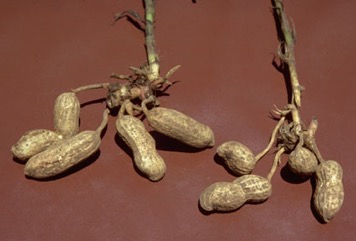
A tropical and subtropical plant. Peanuts grow well from sea level up to about 1650 metres altitude in the equatorial tropics. They need a temperature of about 28°C and between 24°C and 33°C. The plants get killed by frost. They need a well drained soil and cannot stand water-logging. Therefore they are often grown on raised garden beds. They do better in drier areas but need 300 to 500 mm of rain during the growing season. Near harvest dry weather is needed. It is grown between 40° N and 40°S. Short season cultivars are used in semi arid regions. It suits hardiness zones 8-12. In Sichuan and Yunnan.
Also known as:
Akate, Amendoim, Arer, Azi, Badam, Bhui mug, Bombole, Chinabadam pata, Chini-badam, Damsi, Dauphong, Dikomaanti, Dindongo, Drop flower born, Dua phong, Ekpa, Endim-boanjo, Epa, Epa gidi, Fa-sang, Fore-rai, Geda, Goober, Granat, Guerte, Gugia, Gyada, Kacang tana, Kaju-kadala, Kalanga, Kofomboanjo, Kirikaju, Lubalala, Luphuasheng, Ma-kantr, Makate, Mani, Man-kand, Muafumo, Mungafali, Mung-phali, Myay-pe, Nela-gadale, Nelakadala, Neyerem, Nguba, Niki, Nikili, Nikli, Nilakkadalai, Nkate, Nkatie, onyrem, Ntongamane, Nzungu, Nzyngu, Okba, Okpa, Pinati, Pindar, Pitasy, Rakkasei, Rata caju, Ratakaju, Saandaek dei, Thonga, Thua lisong, Tiga, Tikomaanti, Ttangkong, Umbaz, Verkadalai, Verusenagalu
Synonyms
- Arachis nambyquarae Hoehne
Edible Portion
- Seeds, Leaves, Flavouring, Spice, Pods, Vegetable, Oil, Caution
Where does Peanut grow?
Found in: Africa, Amazon, Angola, Antigua-Barbuda, Antilles, Argentina, Asia, Australia, Bangladesh, Barbados, Belize, Benin, Bolivia, Botswana, Bougainville, Brazil, Burkina Faso, Burundi, Cambodia, Cameroon, Canada, Central Africa, Central African Republic, CAR, Central America, Chad, Chile, China, Colombia, Comoros, Congo DR, Congo R, Cook Islands, Costa Rica, Côte d'Ivoire, Cuba, Djibouti, Dominican Republic, East Africa, East Timor, El Salvador, Equatorial-Guinea, Eswatini, Ethiopia, Fiji, France, French Guiana, Gabon, Gambia, Ghana, Grenada, Guadeloupe, Guam, Guatemala, Guianas, Guinea, Guinée, Guinea-Bissau, Guyana, Haiti, Hawaii, Himalayas, Hispaniola, Honduras, India, Indochina, Indonesia, Iraq, Ivory Coast, Jamaica, Japan, Kenya, Korea, Laos, Liberia, Macedonia, Madagascar, Malawi, Malaysia, Mali, Marianas, Martinique, Mauritius, Mexico, Mongolia, Montserrat, Mozambique, Myanmar, Namibia, Nepal, New Zealand, Nicaragua, Niger, Nigeria, North America, Pacific, Pakistan, Papua New Guinea, PNG, Peru, Philippines, Puerto Rico, Reunion, Rotuma, Rwanda, Sao Tome and Principe, SE Asia, Senegal, Serbia, Sierra Leone, Slovenia, Solomon Islands, South Africa, Southern Africa, South America, South Sudan, Spain, Sri Lanka, St. Kitts and Nevis, Sudan, Suriname, Swaziland, Taiwan, Thailand, Timor-Leste, Togo, Tonga, Turkey, Uganda, United States, Uzbekistan, Vanuatu, Vietnam, West Africa, West Indies, West Papua, West Timor, Zambia, Zimbabwe
Notes: There are about 75 Arachis species. After oil is extracted, the residual meal is eaten. Chemical composition (per 100g): Protein = 42.5g. Fat = 9.9g. Calcium = 60 mg. Iron = 9.0 mg. Vitamin B1 = .54 mg. Vitamin B2 = .54 mg. Niacin = 30.7 mg. Kcal = 387.
Status: It is a commercially cultivated vegetable. A very popular snack food in all areas where it can be grown. Seeds are also sold.
Growing Peanut, Groundnut
Cultivation: Peanuts require soil with good levels of calcium or they produce empty pods. Adding gypsum will improve this. If the nutrient boron is short then flowers won't flower and fruit properly. Because peanuts are legumes, they have root nodule bacteria which can fix their own nitrogen and this means they can still give good yields in grassland soils where nitrogen is at a lower level. The seeds or nuts are normally removed from the shell before planting and are sown 2 to 3 cm deep. The alternately branched or Virginia-type of peanuts have a dormancy period so that they must be stored before replanting. A suitable spacing is 10 cm between plants and 60 to 80 cm between rows. Often plants are grown in mixed cultures with other plants but where a pure stand is used up to 250,000 plants per hectare are used. The soil needs to be weeded and loose by the time the flowers are produced to allow the peg for the seed pods to penetrate the soil. Normally when the whole plant dies off the plant are ready to pull. They are left to dry in the sun for 3 or 4 days.
Edible Uses: The seeds can be eaten raw, or cooked. They are boiled, steamed, roasted, salted or made into peanut butter or flour for bread. The young leaves are edible, cooked. The unripe pods are cooked and eaten. Sprouted seeds are eaten. Oil is extracted from the seeds and is edible. It is often used for stir-frying. The remaining meal is also eaten.
Production: Flowering may commence in 30 days. It takes from 3.5 to 5 months till maturity. They are harvested when the top of the plants die. The whole plant is pulled out. Virginia peanuts have a longer growing season and the seeds need to be stored for a while before they will start to re-grow. (30 days.)
Nutrition Info
per 100g edible portion| Edible Part | Energy (kcal) | Protein (g) | Iron (mg) | Vitamin A (ug) | Vitamin c (mg) | Zinc (mg) | % Water |
|---|---|---|---|---|---|---|---|
| Seed dried | 566 | 24.3 | 2 | 0 | Tr | 3 | 4.5 |
| Seed fresh | 333 | 15 | 1.5 | Tr | 10 | - | 45 |
| Leaves | 69 | 4.4 | 4.2 | - | - | - | 78.5 |
| Pods | - | - | - | - | - | - | |
| Sprouts | - | - | - | - | - | - |
Peanut, Groundnut Photos

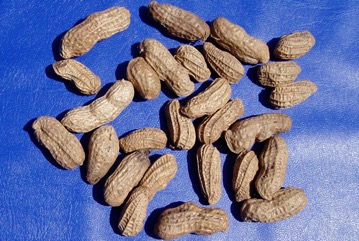
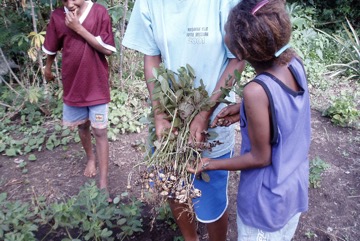
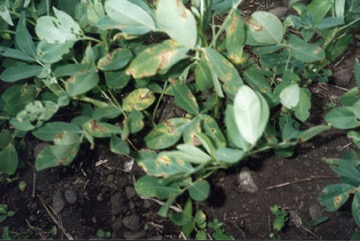
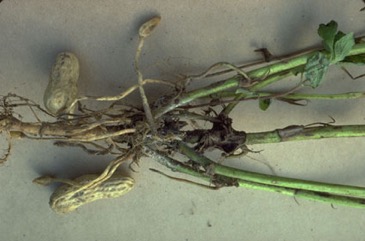
References
Abbiw, D.K., 1990, Useful Plants of Ghana. West African uses of wild and cultivated plants. Intermediate Technology Publications and the Royal Botanic Gardens, Kew. p 31
Ali, A. M. S., 2005, Homegardens in Smallholder Farming Systems: Examples from Bangladesh. Human Ecology, Vol. 33, No. 2 pp. 245-270
Ambasta S.P. (Ed.), 2000, The Useful Plants of India. CSIR India. p 48
Anderson, E. F., 1993, Plants and people of the Golden Triangle. Dioscorides Press. p 202
Ara, R. I. T., 2015, Leafy Vegetables in Bangladesh. Photon eBooks. p 117
Bernholt, H. et al, 2009, Plant species richness and diversity in urban and peri-urban gardens of Niamey, Niger. Agroforestry Systems 77:159-179
BERRY- KOCH
Bianchini, F., Corbetta, F., and Pistoia, M., 1975, Fruits of the Earth. Cassell. p 234
Bircher, A. G. & Bircher, W. H., 2000, Encyclopedia of Fruit Trees and Edible Flowering Plants in Egypt and the Subtropics. AUC Press. p 36
Bodkin, F., 1991, Encyclopedia Botanica. Cornstalk publishing, p 93
Bodner, C. C. and Gereau, R. E., 1988, A Contribution to Bontoc Ethnobotany. Economic Botany, 43(2): 307-369
Bortolotto, I. M., et al, 2018, Lista preliminar das plantas alimenticias nativas de Mato Grosso do Sul, Brasil. Iheringia, Serie Botanica, Porto Alegre, 73 (supl.):101-116
Brouk, B., 1975, Plants Consumed by Man. Academic Press, London. p 219, 238
Burkill, H. M., 1985, The useful plants of west tropical Africa, Vol. 2. Kew.
Chin, H. F., 1999, Malaysian Vegetables in Colour. Tropical Press. p 104
Cobley, L.S. (rev. Steele, W.M.) 2nd Ed., 1976, An Introduction to the Botany of Tropical Crops. Longmans. p 80
Coe, F. G. and Anderson, G. J., 1999, Ethnobotany of the Sumu (Ulwa) of Southeastern Nicaragua and Comparisons with Miskitu Plant Lore. Economic Botany Vol. 53. No. 4. pp. 363-386
Cundall, P., (ed.), 2004, Gardening Australia: flora: the gardener's bible. ABC Books. p 169
Diouf, M., et al, Leafy Vegetables in Senegal. Bioversity webite
Facciola, S., 1998, Cornucopia 2: a Source Book of Edible Plants. Kampong Publications, p 102
Flora of Pakistan. www.eFloras.org
Flowerdew, B., 2000, Complete Fruit Book. Kyle Cathie Ltd., London. p 208
Fowler, D. G., 2007, Zambian Plants: Their Vernacular Names and Uses. Kew. p 36
Fox, F. W. & Young, M. E. N., 1982, Food from the Veld. Delta Books. p 201
French, B., 1986, Food Plants of Papua New Guinea, Asia Pacific Science Foundation p 33
French, B.R., 2010, Food Plants of Solomon Islands. A Compendium. Food Plants International Inc. p 42
Furusawa, T., et al, 2014, Interaction between forest biodiversity and people's used of forest resources in Roviana, Solomon Islands: implications for biocultural conservation under socioeconomic changes. Journal of Ethnobiology and Ethnomedicine, 10:10
Gregory, W.C. & Gregory, M.P., 1979, Groundnut, in Simmonds N.W.,(ed), Crop Plant Evolution. Longmans. London. p 151
Hedrick, U.P., 1919, (Ed.), Sturtevant's edible plants of the world. p 65
Hermandez Bermejo, J.E., and Leon, J. (Eds.), 1994, Neglected Crops. 1492 from a different perspective. FAO Plant Production and Protection Series No 26. FAO, Rome. p15
Hu, Shiu-ying, 2005, Food Plants of China. The Chinese University Press. p 465
Hunter, D., et al, 2019, The potential of neglected and underutilized species for improving diets and nutrition. Planta (2019) 250:709-729
ILDIS Legumes of the World http:www;ildis.org/Legume/Web
Jacquat, C., 1990, Plants from the Markets of Thailand. D.K. Book House p 46
Jardin, C., 1970, List of Foods Used In Africa, FAO Nutrition Information Document Series No 2.p 24, 56
Kays, S. J., and Dias, J. C. S., 1995, Common Names of Commercially Cultivated Vegetables of the World in 15 languages. Economic Botany, Vol. 49, No. 2, pp. 115-152
Khan, D. & Shaukat, S.S., 2006, The Fruits of Pakistan: Diversity, Distribution, Trends of Production and Use. Int. J. Biol. Biotech., 3(3):463-499
Kiple, K.F. & Ornelas, K.C., (eds), 2000, The Cambridge World History of Food. CUP p 433, 1830
Larson, T. J., 1970, Hambukushu Ethno-botany. Botswana Notes and Records. Vol 13.
Latham, P., 2004, Useful Plants of Bas-Congo province. Latham & DFID p 39
Latham, P. & Mbuta, A. K., 2014, Useful Plants of Bas-Congo Province, Democratic Republic of Congo. Volume 1. p 58
Latham, P. & Mbuta, A. K., 2017, Plants of Kongo Central Province, Democratic Republic of Congo. Volume 1. 3rd ed p 63
Lazarides, M. & Hince, B., 1993, Handbook of Economic Plants of Australia, CSIRO. p 23
Lyle, S., 2006, Discovering fruit and nuts. Land Links. p 69
Macmillan, H.F. (Revised Barlow, H.S., et al) 1991, Tropical Planting and Gardening. Sixth edition. Malayan Nature Society. Kuala Lumpur. p 343
Malaisse, F., 2010, How to live and survive in Zambezian open forest (Miombo Ecoregion). Les Presses Agronomiques de Gembloux.
Manandhar, N.P., 2002, Plants and People of Nepal. Timber Press. Portland, Oregon. p 92
Martin, F.W. & Ruberte, R.M., 1979, Edible Leaves of the Tropics. Antillian College Press, Mayaguez, Puerto Rico. p 48, 197
Maundu, P. et al, 1999, Traditional Food Plants of Kenya. National Museum of Kenya. 288p
Menninger, E.A., 1977, Edible Nuts of the World. Horticultural Books. Florida p 87
Milliken, W., 2,000, Ethnobotany of the Yali of West Papua. Royal Botanic Garden, Edinburgh (near Baliem)
Molares, S. & Ladio, A., 2012, The Usefulness of Edible and Medicinal Fabaceae in Argentine and Chilean Patagonia: Environmental Availability and Other Sources of Supply. Evidence-Based Complementary and Alternative Medicine. Volume 2012, Article ID 901918, 12 pages, Hindawi Publishing Corporation.
Mulherin, J., 1994, Spices and natural flavourings. Tiger Books, London. p 110
Norrington, L., & Campbell, C., 2001, Tropical Food Gardens. Bloomings Books. p 33
Ochse, J.J. et al, 1931, Vegetables of the Dutch East Indies. Asher reprint. p 363
Omawale, 1973, Guyana's edible plants. Guyana University, Georgetown p 59
Owen, S., 1993, Indonesian Food and Cookery, INDIRA reprints. p 66
Peekel, P.G., 1984, (Translation E.E.Henty), Flora of the Bismarck Archipelago for Naturalists, Division of Botany, Lae, PNG. p 233, 232
Pham-Hoang Ho, 1999, An Illustrated Flora of Vietnam. Nha Xuat Ban Tre. p 975
Plants for a Future database, The Field, Penpol, Lostwithiel, Cornwall, PL22 0NG, UK. http://www.scs.leeds.ac.uk/pfaf/
Plants of Haiti Smithsonian Institute http://botany.si.edu/antilles/West Indies
Purseglove, J.W., 1968, Tropical Crops Dicotyledons, Longmans. p 224
Rajapaksha, U., 1998, Traditional Food Plants in Sri Lanka. HARTI, Sri Lanka. p 216
Rashid, H. E., 1977, Geography of Bangladesh. Westview. p 286
Recher, P, 2001, Fruit Spirit Botanical Gardens Plant Index. www.nrg.com.au/~recher/ seedlist.html p 1
Ruiters-Welcome, A. K., 2019, Food plants of southern Africa. Ph.D. thesis. Univ. of Johannesburg p 55
Salako, V. K. et al, 2013, Home gardens: an assessment of their biodiversity and potential contribution to conservation of threatened species and crop wild relatives in Benin. Genet Resour Crop Evol
Segnon, A. C. & Achigan-Dako, E. G., 2014, Comparative analysis of diversity and utilization of edible plants in arid and semi-arid areas in Benin. Journal of Ethnobiology and Ethnomedicine 2014, 10:80
Shava, S., et al, 2009, Traditional food crops as a source of community resilience in Zimbabwe. International Journal of the African Renaissance 4(1)
Sillitoe, P. 1995, An Ethnobotanical Account of the Plant Resources of the Wola Region, Southern Highlands Province, Papua New Guinea. J. Ethnobiol. 15(2): 201-235
Small, E., 2009, Top 100 Food Plants. The world's most important culinary crops. NRC Research Press. p 409
Solomon, C., 2001, Encyclopedia of Asian Food. New Holland. p 275
Song, M., et al, 2013, Traditional knowledge of wild edible plants in Jeju Island, Korea. Indian Journal of Traditional Knowledge. 12(2) pp 177-194
Sp. pl. 2:741. 1753
Sukenti, K., et al, 2016, Ethnobotanical study on local cuisine of the Sasak tribe in Lombok Island, Indonesia. Journal of Ethnic Foods. 3 (2016) 189-200 p 198
Terra, G.J.A., 1973, Tropical Vegetables. Communication 54e Royal Tropical Institute, Amsterdam, p 25
Thaman, R.R., 1976, The Tongan Agricultural System, University of the South Pacific, Suva, Fiji. p 381
Tindall, H.D., & Williams, J.T., 1977, Tropical Vegetables and their Genetic Resources, International Board for Plant Genetic Resources, Rome, p 77
Tindall, H.D., 1983, Vegetables in the Tropics, Macmillan p 250
Tredgold, M.H., 1986, Food Plants of Zimbabwe. Mambo Press. p 35
Urgamal, M., Oyuntsetseg, B., Nyambayar, D. & Dulamsuren, Ch. 2014. Conspectus of the vascular plants of Mongolia. (Editors: Sanchir, Ch. & Jamsran, Ts.). Ulaanbaatar, Mongolia. “Admon“ Press. 334pp. (p. 121-143).
Valder, P., 1999, The Garden Plants of China. Florilegium. p 351
van Wyk, B., 2005, Food Plants of the World. An illustrated guide. Timber press. p 66
van Wyk, Be, & Gericke, N., 2007, People's plants. A Guide to Useful Plants of Southern Africa. Briza. p 20
van Wyk, Ben-Erik, 2019, The diversity and multiple uses of southern African legumes. Australian Systematic Botany, 2019, 32, 519–546
Vasquez, R. and Gentry, A. H., 1989, Use and Misuse of Forest-harvested Fruits in the Iquitos Area. Conservation Biology 3(4): 350f
Verdcourt, B., 1979, Manual of New Guinea Legumes. Botany Bulletin No 11, Division of Botany, Lae, Papua New Guinea. p 381
Vickery, M.L. and Vickery, B., 1979, Plant Products of Tropical Africa, Macmillan. p 24, 29
Walter, A. & Lebot, V., 2007, Gardens of Oceania. ACIAR Monograph No. 122. p 232
Wickens, G.E., 1995, Edible Nuts. FAO Non-wood forest products. FAO, Rome. p 33
Williams, C.N., Chew, W.Y., and Rajaratnam, J.A., 1989, Tree and Field Crops of the Wetter Regions of the Tropics. Longman, p 202
Williamson, J., 2005, Useful Plants of Malawi. 3rd. Edition. Mdadzi Book Trust. p 28
Wiriadinata, H., Ethnobotany of Economic Plants in the Baliem Valley, Jayawijaya, Irian Jaya, Indonesian Institute of Science, Bogor, Indonesia
World Checklist of Useful Plant Species 2020. Royal Botanic Gardens, Kew